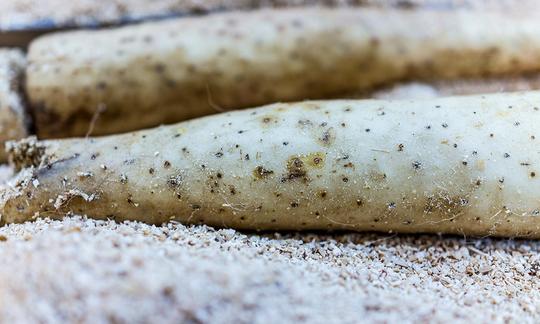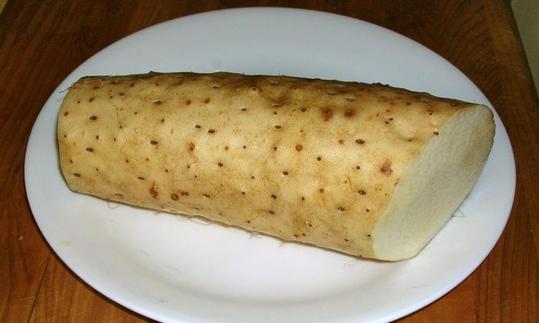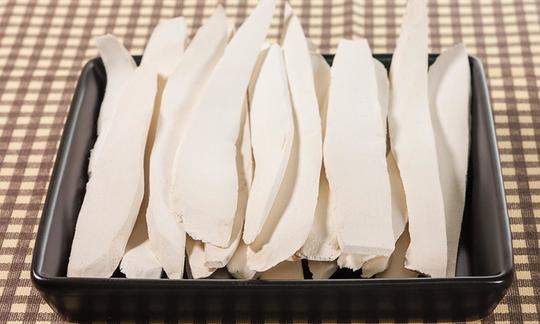Table of contents
The Chinese yam ( Dioscorea batatas or Dioscorea polystachya), also called light root and nagaimo, is a species of the plant genus Yams that produces edible root tubers (also raw).
Uses in the kitchen
The Chinese yam, also often called light root or nagaimo, is one of more than 600 species of yams. In this article we focus on this particular species, while in a separate article the yam is described as a genus with all kinds of species.
Small yams are usually cooked whole. Larger ones are cut into smaller pieces before cooking. The Chinese yam tastes slightly sweet and is reminiscent of chestnuts or potatoes. Its taste, texture and appearance are also similar to the equally unrelated sweet potato. The skin is dark brown to black and the flesh is whitish to light yellow. When cut, mucus comes out which disappears when heated. Can you eat yams raw? Yams are suitable for cooking, steaming, baking, roasting and deep-frying, but can also be eaten raw as they are one of the few types of yam that can be eaten raw and are not poisonous when raw. In Japan, they are often eaten grated in a noodle pan or soup, as part of the dish Okonomiyaki, or as a side dish. Raw and briefly marinated in vinegar water, the root is also eaten with rice for breakfast.
How can you prepare yams? The Chinese yam can be used raw (with the skin on) as a dip or chopped into a salad - wonderful with soy sauce and citrus fruits such as oranges. You can also cut the root into slices and briefly fry them on both sides in a little oil and soy sauce. Yams also taste excellent fried with all kinds of vegetables (e.g. carrots, zucchinis, red bell peppers) and mushrooms and seasoned with garlic and ginger. Finely chopped, the roots can also be dried to make chips. The crushed yam can also be used to make cakes filled with, for example, a date paste. The root can also be used to make a starchy flour that can be used for baking or to make noodles.
Vegan recipe for light root okra salad
Ingredients (for 2 people): 100 g Chinese yam (raw), 2 tomatoes, 8 okras, 3 tsp soy sauce, 1 tsp sesame oil, 1 tsp balsamic vinegar, a little salt.
Preparation: Clean the Chinese yam, peel it and cut it into cubes. Rinse the tomatoes, squash one of them in a small bowl and cut the other into thin slices. Rinse the okra and cut off the ends and stems. Put some salt on a cutting board and roll the okra in it. Bring water to the boil in a pot and blanch the okra in it for about 30 seconds. Remove, rinse with cold water and halve. Put the yams, okra and tomato slices in a bowl and mix with 2 teaspoons of soy sauce and sesame oil. Mix the tomato puree with the remaining soy sauce and balsamic vinegar and pour over the vegan red root okra salad.
Vegan Chinese yam recipes can be found under the note: " Recipes that have the most of this ingredient ".
| Not only vegans or vegetarians should read this: Vegans often eat unhealthily. Avoidable nutritional errors. |
Purchasing - Storage
Where can you buy Chinese yams? Most supermarkets in Europe (e.g. Coop, Migros, Denner, Volg, Spar, Aldi, Lidl, Rewe, Edeka, Hofer, Billa) do not stock the light roots. The root is also usually not available in organic supermarkets (e.g. Alnatura, Denn's Biomarkt). Chinese yams are best found in well-stocked Asian shops or you can buy them online.
What can you use as a substitute for Nagaimo? If necessary, you can use sweet potatoes instead of yams - but they are not a real substitute for yams.
Storage tips
The Chinese yam can be stored in the peel for several weeks in the vegetable compartment of the refrigerator or in a cool, dry storage cellar.
Ingredients - Nutritional values - Calories
The Chinese yam (raw) contains 118 kcal per 100 g, most of which comes from carbohydrates (28 g/100g). Fat is barely present at 0.17 g/100g. The protein content is also rather low at 1.5 g/100g. Raw cassava (1.4 g/100g) and raw sweet potatoes (1.6 g/100g) have comparable protein contents. Raw potatoes are only slightly richer in protein at 2 g/100g. 3
Raw chickpeas are rich in potassium. The content of 816 mg/100g (41% of the daily requirement) is comparable to that of raw chickpeas (718 mg/100g). Raw kidney beans (1,406 mg/100g) are particularly rich in potassium. 3
100 g of Chinese yams (raw) contain 17 mg of vitamin C (ascorbic acid) - This makes up 21% of the daily requirement. Parsnips (17 mg/100g) and cassava (21 mg/100g) contain a similar amount. Yellow bell peppers contain 184 mg/100g, almost eleven times as much vitamin. 3
The vitamin B6 (pyridoxine) content is 0.29 mg/100g (21% of the daily requirement). Potatoes (0.3 mg/100g) and wheat (0.27 mg/100g) contain a similar amount. Pistachios contain significantly more of the vitamin, at 1.7 mg/100g. 3
The complete ingredients of Chinese yam, the coverage of the daily requirement and comparison values with other ingredients can be found in our nutrient tables. In the article Nutrients explained you will get a detailed insight into the topic.
Effects on health
Which substances are responsible for the Chinese yam effect? The root tubers of the Chinese yam are rich in nutrients, but also contain bioactive metabolites such as resistant starch, steroidal sapogenins (such as diosgenin) and mucopolysaccharides, which can have a positive effect on health. For example, they help prevent cardiovascular diseases, diabetes and disorders of the intestinal microbiome. The tubers also contain antioxidants and have a positive effect on the immune system - partly due to the mucopolysaccharides - which is probably related to the ability to regulate inflammation. 1,4
The results of a Korean study from 2018 indicate that oral supplementation with sakura extract has a protective effect on the gastric mucosa and can effectively reduce inflammatory reactions through antioxidant activities and thus prevent and alleviate stomach ulcers. 5 In 2005, the China Medical University in Taiwan was able to achieve a positive effect on rabbits with arteriosclerosis by supplementing with powdered sakura, which has an antioxidant and hypolipidemic effect. In humans, it is assumed that it has a preventive effect against oxidative stress and the resulting arteriosclerosis. 6
Allantoin is another active ingredient found in the Chinese yam, which stimulates cell proliferation and thus accelerates healing processes. The tuber is also used internally to treat digestive problems, loss of appetite, chronic diarrhea, asthma and dry coughs. It is used externally for ulcers, boils and pustules. 4 In addition, the yam has cholesterol-lowering and antifungal properties and counteracts neuroinflammation. 7
The Chinese yam root and its bark are also said to have a stimulating effect on the mineralization of osteoblasts, which is central to the formation and regeneration of bones. 8
Another advantage of the Chinese yam is its lack of toxicity when raw. It shares this property with Discorea japonica (Japanese yam or Yamaimo).
Dangers - Intolerances - Side effects
A study from Korea in 2008 investigated allergic reactions triggered by the lichen in patients who had previously been sensitized via oral or inhalation routes and identified the substance Discorin as the causative allergen. 9
Folk medicine - natural medicine
Is yam root used in Chinese medicine? Traditional Chinese Medicine ( TCM) attributes tonic effects on the lungs, kidneys and spleen to the Chinese yam root. In addition, this yam root is used in TCM to treat digestive problems, fatigue, loss of appetite, leucorrhagia, spermatorrhea and cough, among other things. 10
In oriental folk medicine, the tuber is valued for its strengthening, cough suppressant, expectorant and anti-ulcer effects. 7
Yam root for those wanting to have children? Some recommend taking yam roots if you want to have children, as the diosgenin it contains is said to stimulate the production of progesterone, which is important for preparing the body for pregnancy - scientific evidence is pending.
Ecological footprint - animal welfare
The ecological CO2 footprint of food depends on several factors, including the cultivation method, the country of origin and the corresponding transport, packaging and processing. 12 Despite extensive research, we were unable to find any precise values for the ecological footprint of yams. A large part of Chinese yam cultivation takes place in China and Southeast Asia, cultivation in other areas such as Europe has so far only taken place sporadically due to the high demands of the plant. 13 The transport routes that the root has to travel in our trade are correspondingly long. This is associated with an increased amount of emissions, which has a negative impact on the ecological footprint.
The amount of water needed to produce 1 kg of yams is 324 litres, which is similar to the amount for pumpkins (336 litres) and slightly more than the amount for potatoes (287 litres). 14
Since all parts of the Chinese yam root can be used, it is suitable for the circular bioeconomy, among other things. The tubers could be used to produce food and pharmaceutical products, while the peel can be used as animal feed or in aquaculture. 13
Worldwide distribution - cultivation
The Chinese yam is native to China, Korea, Taiwan and the Kuril Islands, but has also been introduced to Japan, the southeastern USA, Uruguay and the western Himalayas. Archaeological finds from China indicate that the tuber was used around 6,2000-5,200 BC. Further evidence even suggests that it was used around 30,000 BC. The species was fully domesticated around 1,000 years ago. 1
During the Great Famine in Ireland due to the widespread spread of potato blight ( Phytophthora infestans), the Chinese root was introduced as a possible alternative to the potato. Today, however, the Chinese yam has largely disappeared from Europe. Only in France near Orleans and in Germany near Lake Constance is Chinese root still grown. 1
China is currently the largest exporter of the light root, followed by Mexico and the USA. The world's largest importers include the USA, Japan and the United Kingdom. 1
Found in the wild
The Chinese yam ( Dioscorea batatas, Dioscorea polystachya) is native to China, Korea, Taiwan and the Kuril Islands. 1 In some regions of the world (eg parts of the USA) the wild plant is considered invasive. 2 Wild yams grow naturally in forests, on mountain slopes, along rivers and roadsides. 1 We notice that many websites copy the incorrect spelling Dioscorea batata from one another. Batata dulce would be the sweet potato.
Cultivation - Harvest
The Chinese yam can tolerate much colder temperatures than its relatives and is therefore native to temperate regions. The climbing plants like nutrient-rich, loose soil with a sandy texture and a sunny location. 1
It needs a climbing aid or, in nature, climbs up the edges of woodland or trees. The roots grow vertically one to two meters into the ground and can weigh several kilograms. They form drop-shaped tubers - the deeper the thicker, which is something to bear in mind when cultivating them. It is also known as a scented plant due to its small white flowers with a warm, earthy, cinnamon-like scent. After flowering, the brood tubers fall to the ground, from which new offspring grow the following year. 11
Possibility of confusion
With over 600 species of yam, it can easily become confused. The Chinese yam is also not related to the yam bean ( Pachyrhizus erosus).
Further information
The Chinese yam ( Dioscorea batatas or Dioscorea polystachya) is a species of the plant genus Dioscorea, also called yams and yam, which belongs to the yam family (Dioscoreaceae).
Alternative names
Other names for the Chinese yam are Chinese yam, Chinese yam, light root, colic root and rheumatism root.
In Japan, depending on its shape, it is called Nagaimo (cylindrical), Tsukuneimo (round) or Ichoimo (flattened). In China, the name 'Huai Shan Yao' is common. epping In English, the Chinese yam is called Chinese yam or cinnamon vine.
The scientific name often causes confusion and inconsistencies. In literature, the root tuber is found under the species names Dioscorea polystachya, Dioscorea batatas (batata without the s is wrong!), Dioscorea pseudobatatas or, incorrectly, Dioscorea opposita or Dioscorea oppositifolia. 1
Bibliography - 14 Sources
| 1. | Epping J, Laibach N. An underutilized orphan tuber crop-Chinese yam : a review. Planta. 2020;252(4):58. |
| 2. | Dnr.wisconsin.gov Chinese yam; Indian yam. |
| 3. | USDA United States Department of Agriculture. |
| 4. | Choi EM. Koo SJ. Hwand JK. Immune cell stimulating activity of mucopolysaccharide isolated from yam (Dioscorea batatas). Journal of Ethnopharmacology. 2004;91(1):1–6. |
| 5. | Byeon S, Oh J, Lim JS, Lee JS, Kim J-S. Protective effects of dioscorea batatas flesh and peel extracts against ethanol-induced gastric ulcer in mice. Nutrients. 2018;10(11):1680. |
| 6. | Chang W-C, Yu Y-M, Wu C-H, Tseng Y-H, Wu K-Y. Reduction of oxidative stress and atherosclerosis in hyperlipidemic rabbits by Dioscorea rhizome. Can J Physiol Pharmacol. 2005;83(5):423–30. |
| 7. | Lim JS, Oh J, Yun HS, Lee JS, Hahn D, Kim J-S. Anti-neuroinflammatory activity of 6,7-dihydroxy-2,4-dimethoxy phenanthrene isolated from Dioscorea batatas Decne partly through suppressing the p38 MAPK/NF-κB pathway in BV2 microglial cells. J Ethnopharmacol. 2022;282:114633. |
| 8. | Kim S, Shin M-Y, Son K-H, Sohn H-Y, Lim J-H, Lee J-H, u. a. Yam (Dioscorea batatas) root and bark extracts stimulate osteoblast mineralization by increasing ca and p accumulation and alkaline phosphatase activity. Prev Nutr Food Sci. 2014;19(3):194–203. |
| 9. | Hur G-Y, Park H-J, Kim H-A, Ye Y-M, Park H-S. Identification of Dioscorea batatas (Sanyak) allergen as an inhalant and oral allergen. J Korean Med Sci. 2008;23(1):72–6. |
| 10. | Encyclopedia.com Chinese yam. |
| 11. | Gartenrot.com Chinesische Yamswurzel. |
| 12. | Reinhardt G, Gärtner S, Wagner T. Ökologische Fussabdrücke von Lebensmitteln und Gerichten in Deutschland. Institut für Energie - und Umweltforschung Heidelberg. 2020. |
| 13. | Epping J, Laibach N. An underutilized orphan tuber crop—Chinese yam : a review. Planta 252, 2020. |
| 14. | Mekonnen MM, Hoekstra AY. The green, blue and grey water footprint of crops and derived crop products. Hydrol. Earth Syst. Sci. 2011; 15: 1577-1600. |












Comments